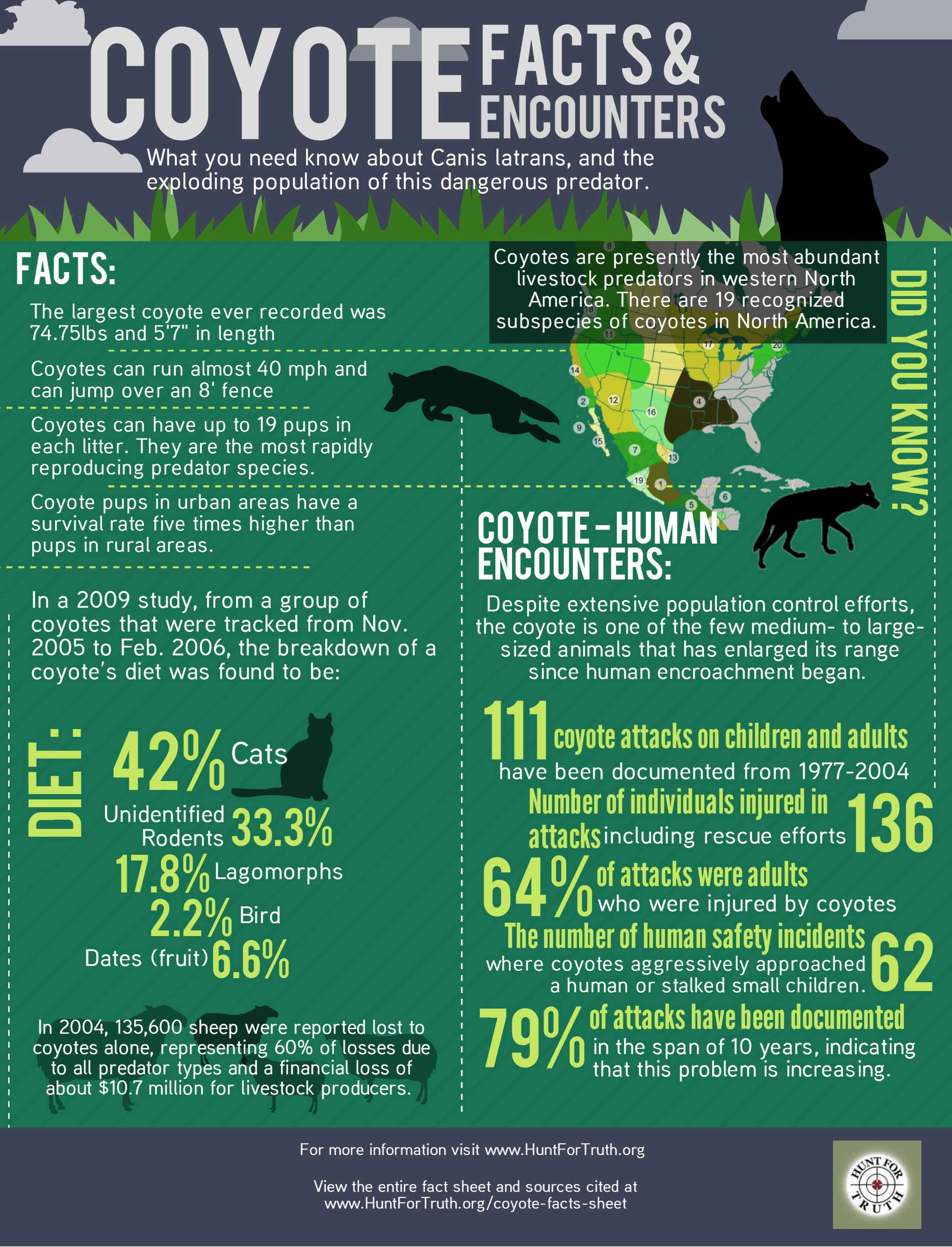Urban coyote populations have risen dramatically during the last decade, most prominently in Illinois, Colorado, and California, where a rising frequency of attacks on domestic pets and children have communities frightened. Given the coyote’s ability to reproduce at exponential rates, and the lack of predators that feed on coyotes, their incursions into urban communities create dangerous long-term consequences that are not being adequately addressed by cities or state fish & game authorities. In many urban areas coyotes have become habituated to seeing man's pets and man himself as a food source, which has resulted in countless scary encounters.
CONTACT THE FISH & GAME COMMISSION
The California Fish & Game Commission is currently being lobbied by animal-rights groups like the Humane Society and Project Coyote to give state-wide protected status to California’s coyote populations so that coyote populations will soar. Allowing this to happen could have catastrophic results for cities and towns.
Without active management, this growing and dangerous rapidly repopulating predator will continue to overrun our neighborhoods.
Click on the button below and send a message to the California Fish & Game Commission stating that you want something done about the increasing threat of urban coyote attacks on pets and children, and that you want the Commission to adopt a predator management plan that considers the local impact of increased coyote and other predator populations. Tell the commissioners to reject the misguided approaches being pushed by Humane Society and Project Coyote.
Also, encourage your local officials to stand on the side of the safety of their community and control coyote populations. Tell your local officials to let the Commission know the coyote intrusion problem needs to be solved by less coyotes, not more! Let the Commission know that you want a solution to the coyote problem now.
WATCH COYOTE ENOUNTERS AND ATTACKS
So-called "animal activist" groups such as the Humane Society of the United States (HSUS) and Project Coyote have marketed the concept of accepting these levels of harm to pets and children as a natural consequence of Mother Nature. Both groups have worked to overturn the current protocols in place with the North American Wildlife Management Model. In place of this model that has served the U.S.'s human-wildlife balance so well for well over 100 years, they advocate that urban communities should "co-exist" with this dangerous predator by keeping their children and pets indoors, and chase after packs of coyotes banging on pots and pans.
Both HSUS and Project Coyote have aggressively promoted this type of wishful thinking, with the sophomoric approach of “coyote hazing”. Numerous peer-reviewed studies have shown that such "hazing" has been unsuccessful as a long-term solution: “Once coyotes have begun acting boldly or aggressively around humans, it is unlikely that any attempts at hazing can be applied with sufficient consistency or intensity to reverse coyote habituation.”[1] Nevertheless, these groups continue to push this fallacy, trying to pass it off as legitimate wildlife management policy that state fish & game authorities should adopt. And, they try to convince communities suffering from coyote issues that it is the only option.
Published peer-reviewed studies have demonstrated that most attacks have followed increasingly bold urban coyote behaviors such as sightings during daylight hours, attacks on pets on leashes, chasing of joggers and bicyclists, as well as mid-day sightings in and around children’s play areas.[2] This is not indicative of an animal that would be deterred by mere "hazing." And those same studies show that coyotes demonstrating such behavior are likely too far beyond being susceptible to “hazing.”
In a 2007 study entitled “A Review of Successful Urban Coyote Management Programs implemented to prevent or reduce attacks on Humans and Pets in Southern California,” trapping was found to be the most effective way to remove coyotes and re-instilling their fear of humans. In other cases, permanent removal was the only option when dealing with highly dangerous and threatening coyotes.[3]
[1] Baker, Rex O., (2007) A Review of Successful Urban Coyote Management Programs Implemented to Prevent or Reduce Attacks on Humans and Pets in Southern California, Wildlife Damage
Management Conferences — Proceedings. Paper 58
[2] Timm, R. M., Baker, R. O., Bennett, J. R., & Coolahan, C. C. (2004) Coyote Attacks: An Increasing Suburban Problem, Proceedings of the Twenty-First Vertebrate Pest Conference, 1.
[3] Timm, R. M., & Baker, R. O. (2007) A History of Urban Coyote Problems, Wildlife Damage Management Conferences – Proceedings, 76
View the full size and sources cited here: Coyote Fact Sheet
WHY THE HSUS MODEL OF CO-EXISTING WITH COYOTES DOES NOT WORK:
"Hazing: is not a long-term solution for dealing with the rapidly growing urban coyote population.
Coyote experts have explained that "once coyotes have begun acting boldly or aggressively around humans, it is unlikely that any attempts at hazing can be applied with sufficient consistency or intensity to reverse coyote habituation."
Coyotes are smart, adaptive creatures and quickly become accustomed to human interaction, and will eventually not be frightened by hazing, if at all.
Coyotes have already shown less fear when encountering a human who has attempted to haze the coyote. In many cases, they will not react and stand their ground.
Hazing is less effective when there is a large number of a coyotes present.
Hazing can pose potential physical risks to people confronting coyotes that Project Coyote and HSUS have not discussed.
HSUS states that attacks on humans are rare, but in comparison to what?
Though attacks may have been statistically rare in the past, urban coyote population growth has rapidly increased. The number of coyote encounters has increased; that the number of attacks on humans has already risen and will likely continue to do so.
Attacks on pets and people can be made even more rare, as they used to be, by returning to coyote management policies that have been proven to work.
Coyote prey on midlevel predators, which includes cats that are either feral or family pets.
A coyote does not have the ability to distinguish a feral cat from a family pet.
The HSUS believes a solution to this problem is to keep your pet indoors after dusk, but coyotes have been seen roaming neighborhood streets in broad daylight and entering people's property.
Restricting your pet to staying indoors is inhumane and does not give your pet the potential to live a full lifestyle.
Coyotes can track possible prey for weeks
Coyotes are known for their ability to be stealthy. They have also been known to return to a sight once they feel a meal is easy to come across.
Documented attacks on children, teenagers, and adults have stated that the coyote has attacked the human from behind.
Are children safe in public areas such as playgrounds where coyotes can lurk nearby?
The coyote’s rate of reproduction can lead to litters of up to 19 pups.
With coyotes reproducing at this rate, urban coyote populations may soon overrun our cities without management.
Most animals with protected status have reproduction rates of 1-2 offspring; coyotes’ litters are more comparable to those of a rat.
And their pups' survival rate increases expotentially in urban environments, making their numbers increase even quicker.
WHAT DO EXPERTS SAY IS THE SOLUTION?
There is no single fix to the problems raised by urban coyotes. But, unlike the "co-existing" approach, the experts overwhelmingly advocate at least some lethal controls. Southern California coyote expert Rex Baker, who has participated in writing numerous papers on coyotes, has stated that lethal controls such as trapping and sometimes shooting are the most effective tools in removing problem coyotes, stopping aggressive behavior, and re-instilling fear of humans.
Baker has observed that lethal removal of problem coyotes can, in some cases predictably, cause the remaining coyotes to either leave the area or become much more wary of humans, a behavior that may persist for quite some time.
There is no scientific support that lethal controls of coyotes increase their populations. Regardless, population sizes are not as important as behavior.
PEER REVIEW STUDIES:
Coyotes Nipping at our Heals: A New Suburban Dilemma - Robert M. Timm (2007)
A History of Urban Coyote Problems – Robert M. Timm, Rex O. Baker [2007]
Sheep-Killing Coyotes a Continuing Dilemma for Ranchers – Robert M. Timm, Guy E. Connolly [2001]
The Urban Coyote Problem in Los Angeles County – Robert G. Howell [1982]
MAP OF COYOTE ENCOUNTERS IN ORANGE COUNTY
View a map of documented sightings of coyotes in Orange County
VIDEOS OF COYOTE SIGHTINGS, ENCOUNTERS, AND ATTACKS
READ ARTICLES ABOUT COYOTE SIGHTINGS, ENCOUNTERS, AND ATTACKS
Burbank Residents Inundated, Scared By Large Packs Of Coyotes
Coyotes In Hancock Park Have Residents On Edge
Irvine father: 'Huge' Coyote Hunted his Baby Boy
Laguna Beach Residents Warned To Keep Pets Indoors After Multiple Coyote Attacks
Coyote Drags 2 Year-Old Girl at Southern California Cemetery
Toddler Attacked By Coyote In Colorado Springs
Coyotes Attack Colorado Man Walking to Work





